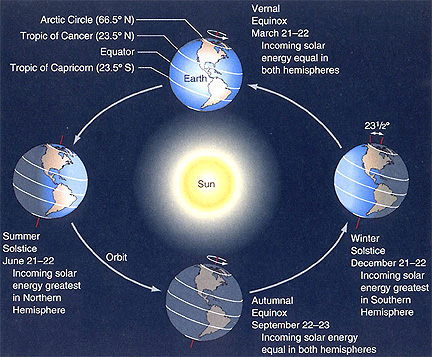Winter officially begins every year on the day of the winter solstice. Typically, this astronomical event occurs on December 21 or 22 (in the Northern Hemisphere), though it can occur anywhere between December 20 and 23.
What is the Winter Solstice?

Earth’s Seasons are determined by the combination of the tilt of the Earth and its position along its orbit around the sun. (Source: NASA.gov)
The Winter Solstice is the shortest day of the year and the longest night. This year in Arizona we can expect just over 10 hours of daylight. In spots farther north, the days will be markedly shorter. For example, Glasgow, Scotland will experience approximately seven hours of daylight; Fairbanks, Alaska will only experience a meager four hours of daylight, as the sun will barely peek over the southern horizon there. There are even places that will see no sunrise at all, like Barrow, Alaska. For the polar regions, the solstice will leave them in darkness for more than 24 hours.
Why does this happen?
The Earth is tilted; it does not face the sun upright, instead our planet lies at a 23.5⁰ angle. This is one of the reasons why the seasons on Earth seem to be reversed between the Northern and Southern Hemispheres. When the Northern Hemisphere is tilted toward the sun, residents of areas on that part of the planet have summer while residents below the equator are experiencing winter. While on December 21 the U.S. will be having it’s shortest day of the year, countries like Australia, Madagascar, and Chile will be having their Summer Solstice, which is the longest day of the year, because the Southern Hemisphere is tilted closer to the sun this time of year.
As the Earth orbits the sun, the amount of daylight each day changes in response to both the angle and the location of the planet along that year-long track. The angle of the Earth means that the sun position in our sky moves along a north-south path throughout the year. The days shorten as the sun moves toward the Southern Horizon (moving toward the Winter Solstice) and lengthen as it moves northward again, reaching its zenith with the Summer Solstice.[i]
What does this mean?
Since ancient times this event, which signals the start of winter, has been an important one in the cultural lives of many civilizations from the Maya and Incas in Central and South America to the Celts in Ireland and Scotland and the Scandinavian and Germanic peoples.
Most ancient humans used astronomical events, like solstices and equinoxes, to determine agricultural practices, like planting crops, monitoring winter food stores, and mating livestock. The Winter Solstice marked the approach of what was called the “famine months.” Historically, January to April were the coldest and harshest months in many climates and the times when food was most scarce, which meant it was the time when people were most likely to suffer or succumb to starvation or freezing, depending on the climate of their home regions.
The cultural meaning of the Winter Solstice is as varied as the cultures present on our planet, but there are a great number of holidays, festivals, gatherings, rituals, and other celebrations held around this time of year. Some are even still practiced today: Christmas, Yule, Saturnalia, the Long Night, and the start of winter. In some cultures, the Winter Solstice marked the last feast day before the lean times of winter ahead. It is also thought to have been viewed as the turnaround toward spring and summer, thus marking it as a day for celebration. It is this view that could explain the association of the Winter Solstice with the concept of rebirth and renewal.
The solstice was important enough in these cultures to dictate the construction of massive monuments. There are several monuments that face, frame, or otherwise highlight the Winter Solstice sunrise and sunset. While there are hundreds in Egypt alone, let alone throughout the world, below you will find a few from different parts of the world:
- In Egypt, the Temple of Karnak was constructed so that the entrance faces directly at the location of the Winter Solstice sunrise, allowing the sun’s light to flood through the temple all the way to the altar of Amun, the patron deity of Thebes, who merged with the Old Kingdom sun god Ra.
- In the ancient Mayan city of Tulum in Mexico, there is a building which is still standing that has a small cap with a hole in it; on solstice days, both June and December, the light of the sun passes through that feature and creates a brilliant starburst effect.
- In Ireland, there is a massive one-acre burial mound at Newgrange which was constructed to capture the light of the Winter Solstice sunrise. The only time the central chamber and tunnel of this catacomb is lit by the sun is on this day, and then only for 17 minutes.
- In Saxony-Anhalt, Germany, the Goesick circle, dating back to 4900 BC, was rediscovered in 1990; in the outermost circle archaeologists discovered two gates which align with the sunrise and sunset of the Winter Solstice.
- If you would like to know more about ancient monuments with astronomical alignments, NASA’s Sun-Earth Day 2011 hosts a wealth of information on the sun and the Earth’s connection to it, including this article which discusses more well-known examples of ancient sites with simple solar alignments.
Even though the day of December 21 will be short and the night long, just remember there are longer, warmer days to come. So enjoy our beautiful, temperate Arizona weather while you can.
[i] The movement described applies to the Northern Hemisphere. This process happens in the reverse in the Southern Hemisphere. The southerly movement of the sun toward the point of the Summer Solstice, which marks the start of summer, sees a lengthening of days, while the northern movement of the sun in the sky shortens the days for those countries below the equator.


